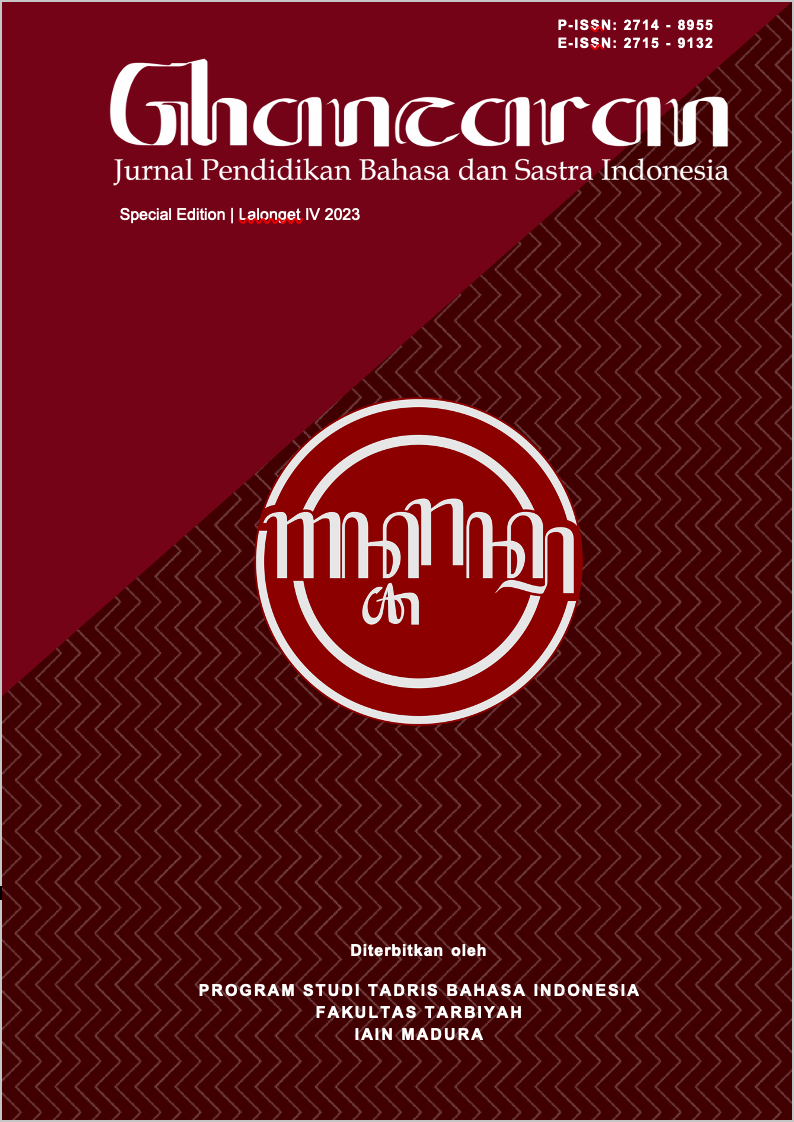Psikolinguistik, Neurolinguistik, dan Metafora Kognitif Komputer dalam Perkembangan Bahasa Teknologi Kecerdasan Buatan
 Abstract views: 1085
,
Abstract views: 1085
,
 PDF downloads: 1053
PDF downloads: 1053
Abstract
The study aims to identify the psychology of language development in artificial intelligence technology systems. The study USES qualitative descriptive methods that will be used to analyze the results of paraphrased students' handwriting using the three artificial intelligence apps Chat GPT, Aizzy AI, and Perplexity AI. The data analysis on this research is based on text and narrative based on its semantic building structure, morphology, and syntax. The data processing process on this research uses simple searches related to specific keywords to get paraphrasing results from all three applications of artificial intelligence. The result of this study was the discovery of significant differences. The significance found is the language processing of the paraphrased text using the same keyword search, both of which use Chat GPT, Aizzy AI, and Perplexity AI.
Downloads
References
Anisa Ulfah, Lailatul Fitriyah, Nur Zumaisaroh, & Elena Jesica. (2023). Pemanfaatan Media Pembelajaran Digital dalam Pembelajaran Menulis Puisi di Era Merdeka Belajar. Ghâncaran: Jurnal Pendidikan Bahasa dan Sastra Indonesia Volume 5, Nomor 1, 2023 Halaman: 42—57
Arifuddin. 2013. Neuropsikolinguistik. Jakarta: Rajawali Pers
Halim, C., & Prasetyo, H. (2018). Penerapan Artificial Intelligence dalam Computer Aided Instructure(CAI). In Jurnal Sistem Cerdas (Vol. 01).
Hidayat, R., Alliyah, S., & Dewi, N. G. (2022). Financial Inclusion, Intellectual Capital, and MSMEs Performance with Business Age as Moderating Variable.
Joni Kawijaya. (2023). Penggunaan Artificial Intelligence Markup Language (AIML) Untuk Menganalisa Kesalahan Menulis Bahasa Arab di MTs Bilingual Batu. Jurnal Jendela Pendidikan Volume 3, Nomor 3, 354-362.
Kusumadewi, Sri. (2003). Artificial Intelligence: Teknik dan Aplikasinya. Yogyakarta:Graha Ilmu.
Kawijaya, J., Agama, I., & Darul A’mal Lampung, I. (2023). Penggunaan Artificial Intelligence Markup Language (AIML) Untuk Menganalisa Kesalahan Menulis Bahasa Arab di MTs Bilingual Batu. Jurnal Jendela Pendidikan, 3(03).
Khansulivong, C., Wicha, S., & Temdee, P. (2022). Adaptive of New Technology for Agriculture Online Learning by Metaverse: A Case Study in Faculty of Agriculture, National University of Laos. 2022 Joint International Conference on Digital Arts, Media and Technology with ECTI Northern Section Conference on Electrical, Electronics, Computer and Telecommunications Engineering (ECTI DAMT & NCON), 428–432.
Lestari, S., Usadiati, W., & Misrita, M. (2022). THE CORRELATION BETWEEN STUDENTS’ ARTIFICIAL INTELLIGENCE AND THEIR ENGLISH READING SKILLS ACHIEVEMENT. Bahasa: Jurnal Keilmuan Pendidikan Bahasa Dan Sastra Indonesia, 3(2), 103–111.
Moleong, Lexy J. (2018). Metodologi Penelitian Kualitatif. Bandung: PT Remaja Rosda Karya
Mustafa, M. N., Hermandra, H., & Zulhafizh, Z. (2019). Teachers’ Strategies to Design Media to Implement Communicative Leaning in Public Schools. Journal of Educational Sciences, 3(1), 13-24.
Penguatan Kesehatan dan Pemulihan Ekonomi Nasional Fitri Andri Astuti, untuk. (2021). Pemanfaatan Teknologi Artificial Intelligence. Jurnal Sistem Cerdas, Vol 4 No 1, 25-34.
Putikadyanto, A. P. A., Wachidah, L. R., Aliyah, I. F., Herawati, S. H., & Abrori, M. (2022). Perubahan Perilaku Siswa dalam Pembelajaran Tatap Muka di Kelas Pascapandemi: Potret Pembelajaran di Awal Era Merdeka Belajar. GHANCARAN: Jurnal Pendidikan Bahasa dan Sastra Indonesia, 1-13.
Rich, Elaine., Knigt, Kevin., Nair, B Shivashankar. (2009). Artificial Intelligence. New Delhi: Tata McGraw-Hill Publishing Company Limited.
Sugiyono. (2015). Metode Penelitian Kualitatif dan R&D. Bandung: Alfabeta.
Sudjana, Nana., dan Rivai, Ahmad. (1989). Teknologi Pengajaran. Sinar Baru: Bandung.
Winston, Henry Patrick. (1993). Artificial Intelligence. United States: AddisonWesley Publishing Company
Copyright (c) 2023 GHANCARAN: Jurnal Pendidikan Bahasa dan Sastra Indonesia

This work is licensed under a Creative Commons Attribution-ShareAlike 4.0 International License.
Ghancaran: Jurnal Pendidikan Bahasa dan Sastra Indonesia uses an Open Access Policy under the Creative Commons Attribution-ShareAlike 4.0 International License. Authors publishing in this journal agree to the following terms:
- Ghancaran Journal holds the copyright and grants the journal rights for first publication with the work simultaneously licensed under a

The work is distributed under Creative Commons Attribution-ShareAlike 4.0 International License which allows others to share, copy, and redistribute the material in any media or format and adapt, remix, change, and develop the material even for commercial purposes, as long as it is stated credit and license derivative works under similar terms. - Authors may make additional contractual arrangements for non-exclusive distribution of the journal's published work version.
- Authors are permitted to post their work online (e.g., in institutional repositories or on their websites) before and during submission, as doing so may lead to productive exchange.



















